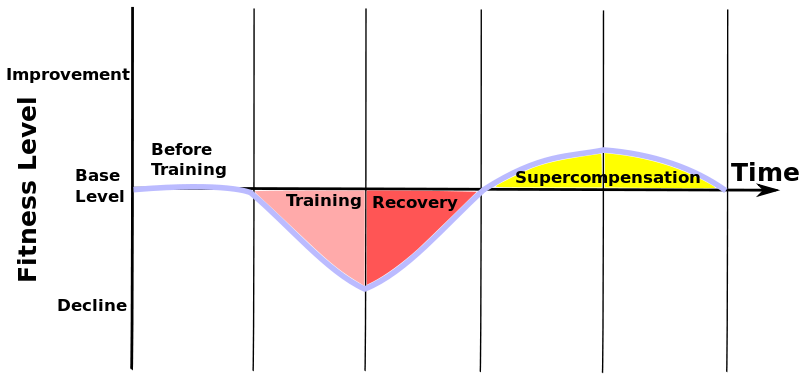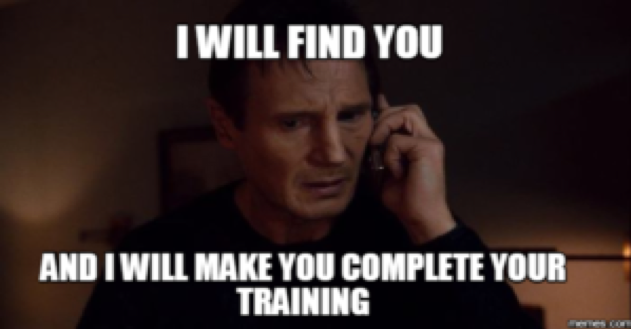Today’s guest post comes courtesy of Syracuse, NY based personal trainer/strength coach, Ricky Kompf1
If you lift weights as your main mode of exercise you’re bound to experience ruts that can be frustrating, and there are many factors to consider.
Ricky weighs in (<— see what I just did there?) on several things to consider on why you may not be seeing the fruits of your labor.
Enjoy!

5 Reasons You Aren’t Getting the Results You Want
This is a constant battle everyone interested in getting fitter or healthier deals with: You start working out a lot, you get a lot of initial gains in your strength, speed, power, endurance and overall performance, and you think “Wow this is awesome!”
You continue to work out the same way and over time you stop getting results. Or, at the very least, progress takes a major nose dive.
You’ve hit a plateau.
This is one of the hardest things to overcome. Many people give up, stop being as motivated, and try to work harder, but crash and burn, leaving a bad taste in their mouth because they aren’t getting the gains they were before.
Sound like you?
Let’s be clear with one thing, reaching peak performance is a marathon not a sprint.
To get past sticking points in your program it will require you to look at your daily actions much more deeply. It will force you to painfully analyze the things you’re really not good at. As long as you can approach this with an open mind of getting better you’ll be able to push through your plateaus.
What follows are the top 5 things I’ve found to be the leading reasons why most people fail at attaining the results they want. Read them over, ponder, let them marinate, and then let’s get to work.
1. You’re Training Too Hard

Believe it or not, there is a such thing as training too hard.
Not that it will always result in “overtraining” but it can and absolutely will result in diminishing rate of returns in the gym.
At a micro level your body can only recover from so much stress on a daily basis and if you consistently go above that threshold every day you’re not going to recover and become stronger. The stronger you become the more likely this can happen.
It’s called the Law of Supercompensation and it helps you to achieve the results that you want.

When you first workout your body becomes weaker, and after you eat, sleep and give you body time to recover you become stronger as an adaption to prevent damage to the body.
Your body literally adapts so you don’t die.
As you continue to ramp up the stimulus of training your body needs more time to recover, or it needs to optimize its ability to recover.
If you fail to allow either to happen the body will stop recovering to baseline and you’ll be in a constant state of fatigue.
Fatigue will mask your true fitness level.
Going into the weeds on this topic with a simple blog post is impossible, but the idea here is to champion RECOVERY. Your results in the gym are directly proportional to how well you allow yourself to recover.
Yeah, yeah, yeah, I can sit here and wax poetic on the importance of sleep, proper hydration, and ensuring ample calories to support your training but…
…zzzzzzzzzzzzzz.
Boring.
NOTE: All there are THE most important factors to consider when discussing recovery. I just know most people tend to black out or lose interest when anyone starts to discuss topics.
One of the best ways to ensure ample recovery and to prevent plateaus in the gym is to “lean into” the ebbs and flows of training volume. Some days/weeks should be hard, some days/weeks should be easy, some days/weeks should be right in the middle (what I like to call Goldilocks days), and then, yes, some days should absolutely make you hate your fucking life.
Here’s an excellent video via Chad Wesley Smith of Juggernaut Training outlining the concept:
2. You’re Not Training Hard Enough

This seems to be an obvious one but it’s very common for someone to get stuck into a routine doing the same thing every time they go to the gym, operate at the same level of intensity, and do the same weights every…single…day.
Your body is very good at adapting to what you do on a regular basis and if you continue to do the same thing day in and day out your body will become so efficient at it that, not only will you stop seeing results, but you actually may begin to regress.
Your body needs novel stimuli that it’s not used to, and you need to change the intensity of your workouts on a regular basis.
If you program calls for you to perform an exercise for eight repetitions and when you’re done you could have completed eight more, you’re not training hard enough…
…and you’re likely seeing sub-optimal results.
I always like to tell people you should leave 1-2 reps in the tank after each set. This tends to be a nice compromise because
- You’ll ensure good technique with each rep.
- You’ll still be lifting an appreciable amount of weight in order to elicit an adaptive response from the body
- And lastly, to piggy back from above, you’ll ensure ample recovery between workouts
Figuring out how much weight you should be using can be a bit of a quagmire.
THIS post from Tony should help those of you who need a little direction.
3. You Have Too Many Daily Stressors

Your body recognizes all stressors as the same thing, and when you have too many stressors – good or bad – it will influence your recovery and results.
These stressors can include: working out, a lack of sleep, fighting ninjas, financial stress, friends and significant other, sick kid, your boss is an asshole, and everything and anything in between.
If it feels like the stress is piling up chances are you won’t be recovering very well either.
Maybe taking a day or two off from working out is what’s needed. However, I recognize that for a lot of people heading to the gym on a daily basis IS stress relief. To that end, maybe something like a Bloop, Bloop, Bloop workout is in the cards?
Meditation is lovely idea.
Or, I don’t know, maybe try some yoga.
Try Neghar Fonooni’s Wildfire Yoga (I.e., yoga for meatheads) which provides a plethora of quick 10-20 minutes “yoga flows” that’ll help declutter your mind but also loosen up that pesky piriformis that’s been nagging you for years.
The idea is that you don’t always need go full-boar, DEFCON 1, OMG-this-workout-was-so-awesome-I-can’t-feel-the-right-side-of-my-face.
If daily stress is high, temper your workouts accordingly.
4. You Need to Change the Focus of Your Program

Many people fall victim to this.
Humans are creature of habit and if something worked in the past, it stands to reason it’ll work today, tomorrow, next week, next year, next decade, you get the idea.
Whether it’s strength training, being a cardio bunny, or going on a bodybuilder body part split…
…everything works until it doesn’t work.
The answer to your past problems – when overdone – will be the source of your new issues.
This is why having a basic understanding of periodization and focusing on different qualities of strength and fitness at different times is so important.
This means taking time to have phases where your main focus is strength, or Hypertrophy, or endurance, or power/speed, or just having better movement.
Change the focus of your program so you can be well rounded and avoid plateaus.
Progress feeds more progress.
5. Do More of What You Suck At

Stop always doing what you’re good at or what you’re familiar with.
If you write your own programs you’ll inevitably lean towards those exercises you’re comfortable with and good at. If you’ve always had a straight bar deadlift and a barbell back squat in your program, I have news for you…
…you don’t need either of them to be strong and get awesome results.
The body doesn’t know what a deadlift or a squat is.
All that happens is a stimulus and an adaptation to the stimulus.
If the stimulus is the same all the time, the adaptation will be less and less significant. Change your variations, go from a straight bar deadlift to a trap bar deadlift, use specialty bars, use accommodating resistance with bands and chains, use eccentrics and isometrics in your training.
There’re so many things you can change or tweak in your program; the options are endless!
Here’s a list of things you can change to create a different stimulus and continue to allow your body to make adaptation:
- Use eccentric and isometrics to limit mechanical stress and master movement of your lifts
- Use chains and bands to overload the top of your lifts, mimic the strength curve, and teach acceleration in your lifts
- Use specialty bars to change the lift slightly and work on weaknesses
- Change your rest periods
- Use unilateral exercises as your main lift (ie, Bulgarian split squats, reverse lunges, single arm presses, etc)
About the Author
Ricky Kompf is the head coach/owner of Kompf Training Systems where we work primarily with team sport athletes like baseball, football, lacrosse and basketball.

He’s also a Head Trainer for a corporation for Bankers Heath Care.
You can give him a follow on Instagram HERE.
You can check him out on Twitter HERE.




